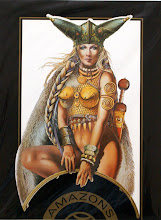Stanley L. Wood was a hugely popular contributor to magazines in the late 19th and early 20th centuries, chiefly remembered for his depictions of the wild west which graced many a boy's story paper. It was the perfect match of subject and talent as Wood was superb at depicting horses in action; He spent some of his teen years in Kansas and he returned to America in 1888 when he was sent to South Dakota by The Illustrated London News. An authenticity infused his illustrations — whether a realistic painting or a cartoon — and his colour plates of the wild west in Boy's Own Paper and Chums have helped keep their respective annuals collectable.
Stanley Llewellyn Wood was born in Maindee, near Newport, Monmouthshire, in 1867, the son of Stanley James Wood, a cement manufacturer, and his wife Charlotte (nee Atkins). He grew up in Christchurch, Monmouthshire, and travelled with his family to America at the age of 12, where his father had bought a ranch in Indian territory in Kansas. Legend has it that the bodies of the former owners, who had been murdered by a raiding party of braves, were buried in the garden. Soon after James Stanley Wood’s death, the house was surrounded by Ute Indians and, to scare them away, Charlotte had her children put on riding boots and spurs and they tramped up and down the stairs and from room to room, making as much noise as possible. The ruse worked and, believing the house to be heavily occupied, the natives retreated.
Charlotte and her family returned to St. Pancras, London and Wood went on to become a prolific illustrator of newspapers and magazines, including Black and White, Cassell’s Magazine, The Graphic, The Harmsworth Magazine, The Idler, The London Magazine, The Pall Mall Magazine, Pearson’s Magazine, The Penny Magazine, The Sporting and Dramatic News, The Strand Magazine, Wide World Magazine, The Windsor Magazine and Young England. Wood’s magazine and book illustrations included works by Cutcliffe Hyne (Captain Kettle), Dr. Nokola by Guy Boothby and Don Q. by Hesketh Pritchard. As a painter he also exhibited at the Royal Academy.
Wood married Mary Elizabeth Jenkins in Fulham on 21 February 1899. They had three children: Stanley Montague, Henry Lawrence and Jack Steward. The family lived in Palmers Green, Middlesex, where Wood died on 1 March 1928, aged 61. He had been ill for some weeks and, although he could not raise himself from his bed unaided, insisted that he continue working on his final illustration – for a ‘Kettle’ story – with his wife and son supporting him.
Examples of Stanley L. Wood's artwork can be found at the Illustration Art Gallery.
Subscribe to:
Post Comments (Atom)




















No comments:
Post a Comment